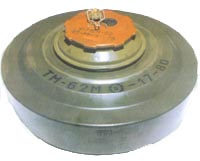| Revision as of 03:13, 28 February 2022 edit109.121.233.87 (talk) added usage in the 2022 invasion of ukraine← Previous edit | Revision as of 19:27, 15 March 2022 edit undoSandstein (talk | contribs)Autopatrolled, Administrators188,550 editsm Sandstein moved page TM-62 series of mines to TM-62: shorterNext edit → |
| (No difference) | |
Revision as of 19:27, 15 March 2022
| This article includes a list of references, related reading, or external links, but its sources remain unclear because it lacks inline citations. Please help improve this article by introducing more precise citations. (December 2014) (Learn how and when to remove this message) |

TM-62 is the designation for a series of Soviet anti-tank blast mines. The mines have a central fuze and typically have a 7.5 kilograms (17 lb) explosive charge, however they vary greatly in detail. The mines can be laid manually or automatically from a mine laying machine including the PMR-1, PMR-2 wheeled towed mine layers, the GMZ tracked mine laying vehicle and the VMR-2 helicopter mine laying system.
In a static test, the TM-62M proved capable of penetrating the hull of a Centurion tank, killing the simulated crew of animals inside.
The TM-62 series of mines can be fitted with the same fuzes as the TM-72 series of mines, which include MVN-72 and MVN-80 fuzes which are vibration and magnetism sensitive.
The mine was used in the 2022 Russian invasion of Ukraine where Ukrainian civilians helped to clear the mines from roads.
Variants
- TM-62M - The TM-62M uses a circular metal case. It is the most widely employed of the TM-62 series of mines.
- TM-62B - The TM-62B paper or cardboard case and is basically a block of cast explosive with a fuze set into the center.
- TM-62D - The TM-62D uses a wooden case.
- TM-62P, TM-62P2, TM-62P3 - all 3 types use plastic cases. However, the TM-62P and TM-62P2 mine cases have ribbed sides, whereas the TM-62P3 has a smooth casing.
- TM-62T - The TM-62T has a fabric and epoxy casing, with a central fuze.
Fuzes
- MVZ-62
- MVCh-62 - The MVCh-62 uses a clockwork arming delay of 30 to 120 seconds.
- MVN-62
- MVN-72 - The MVN-72 fuze uses a combination of electronics and clockwork, after an initial arming delay the magnetic influence fuze is enabled, powered by a 1.5 V battery.
- MVN-80 - The MVN-80 is an improved version of the MVN-72 fuze.
- VM-62Z
- MVP-62 - The MVP-62 uses a pneumatic bellows arming delay of 20 to 300 seconds. The delay mechanism uses a minimum of metal making it difficult to detect when used with one of the minimum metal cases.
- MVP-62M
- ZN-97 - magnetic influence fuze (made in Poland).
Note: magnetic influence fuzes give full-width attack i.e. any part of the target vehicle passing over the mine will trigger detonation, not just the track or wheels. However, since magnetic fuzes are electronic, their operational life relies on battery power. Ultimately the battery will run down, after which the mine no longer functions. In contrast, a purely mechanical fuze (usually triggered via a belleville spring) gives a much longer operational life e.g. mines planted 50 years previously will still detonate if a target vehicle drives over them.
Specifications (TM-62M with MVZ-62 fuze)
- Weight: 9.5 kilograms (21 lb)
- Explosive content: 7.5 kilograms (17 lb) of TNT (although sometimes combinations of RDX/TNT/Aluminium or Amatol mixes are used)
- Diameter: 320 millimetres (13 in)
- Height: 128 millimetres (5.0 in)
- Operating pressure: 150 to 550 kilograms (330 to 1,210 lb)
Users
References
- Jane's Mines and Mine Clearance 2005-2006
- "Russian War In Ukraine - Ukrainian Civilian Removes Landmine From Road Without Any Fear". www.youtube.com. Retrieved 2022-02-28.
See also
- TM-46 anti-tank landmine